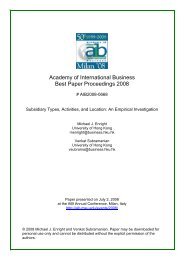AIB 2012 Conference Proceedings - Academy of International ...
AIB 2012 Conference Proceedings - Academy of International ...
AIB 2012 Conference Proceedings - Academy of International ...
You also want an ePaper? Increase the reach of your titles
YUMPU automatically turns print PDFs into web optimized ePapers that Google loves.
SUNDAY<br />
An MNE that diversifies by entering a new product area usually first invests in one start country and<br />
subsequently selects target countries in which to carry out an international rollout. We study 788 new product<br />
area international rollouts by 90 German MNEs and find that rollout speed is positively affected by how closely<br />
related the new product area is to the product areas in the firm's overall, start country, and target country<br />
portfolios. We also find that geographic proximity between start and target country, as well as more already<br />
established firm activities in the target country help increase rollout speed. (For more information, please<br />
contact: Thomas Hutzschenreuter, WHU, Germany: th@whu.edu)<br />
Foreign Entry Timing and Survival: The S-curve Hypothesis<br />
Jing'an Tang, Sacred Heart University<br />
While competitive dynamics literatures suggest firms to enter a foreign market as pioneers to gain first mover<br />
advantages, agglomeration-based location studies, on the other hand, recommend them to enter a market<br />
where a critical mass <strong>of</strong> their peers is already located, that is, to be late movers in order to benefit from the<br />
agglomeration economies. Density dependence theory, however, advises being neither early nor late entrants,<br />
but being entrants in-between for survival advantages. To resolve this apparent paradox, we draw upon<br />
multiple theories to build a foreign entry and survival model to integrate these three entry positions. We argue<br />
that multiple forces interact with one another during the foreign entry process, resulting in an S-shaped<br />
curvilinear relationship between entry order and subsidiary survival. An empirical analysis <strong>of</strong> a sample <strong>of</strong> nearly<br />
4,000 Japanese FDI entries in over 40 countries from 1985 to 2003 supports our model. (For more information,<br />
please contact: Jing'an Tang, Sacred Heart University, USA: tangj3@sacredheart.edu)<br />
Foreign Direct Investment: Domestic Alliance Experience as an Antecedent to <strong>International</strong> Expansion<br />
Linda Rademaker, Tilburg University<br />
Xavier Martin, Tilburg University<br />
This paper examines how collaboration with MNEs may induce knowledge spillovers that can be used as the<br />
foundation on which local firms can build their attempts to expand internationally. Using a sample <strong>of</strong> FDI in- and<br />
outflows into China and the United States in the period 1978-2010 we analyze the likelihood <strong>of</strong> international<br />
expansion <strong>of</strong> Chinese firms. We find a positive effect <strong>of</strong> joint venture experience on the propensity <strong>of</strong> Chinese<br />
firms to conduct FDI in the United States, with strong country effects. In addition, we find that domestic alliance<br />
experience influences the entry mode chosen upon internationalization. (For more information, please contact:<br />
Linda Rademaker, Tilburg University, Netherlands: c.h.a.rademaker@uvt.nl)<br />
Development and Validation <strong>of</strong> a Vertical and Horizontal <strong>International</strong>ization Metric<br />
Edmund R. Thompson, University <strong>of</strong> Bath<br />
The lack <strong>of</strong> valid and reliable measures <strong>of</strong> firm-level vertical and horizontal internationalization is impeding the<br />
development and testing <strong>of</strong> hypothesized relationships between these two different dimensions <strong>of</strong><br />
internationalization and a range <strong>of</strong> important MNE characteristics, actions, and effects. Through a series <strong>of</strong><br />
qualitative and quantitative studies using data collected from a total <strong>of</strong> 3,146 senior MNE executives, this paper<br />
develops and validates a scale to measure both vertical and horizontal internationalization. Subscales for each<br />
type <strong>of</strong> internationalization prove to be unidimensional, reliable, temporally stable, and to have predictive, crosscultural,<br />
cross-sectoral, and discriminant validity. (For more information, please contact: Edmund R. Thompson,<br />
University <strong>of</strong> Bath, United Kingdom: e.r.thompson@bath.ac.uk)<br />
<strong>AIB</strong> <strong>2012</strong> <strong>Conference</strong> <strong>Proceedings</strong><br />
Page 61

















